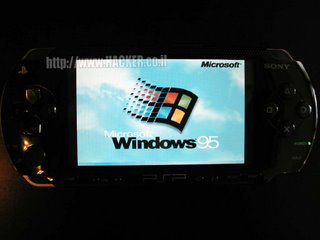 Is your win xp-sp2 pc driving u crazy because of its "warp-speeds"??. Then this little piece of info is for u. I actually came across this in a techtree.com article. It was durin my "norton days" .My pc was just a few weeks old and after insllin NAV general sys speed had gone down a bit. I wldnt hv minded a speed drop of that amount NOW. But when uve just bought a new pc even a sliiight performance drop can make u wonder whether u bought the right PC. This article actually gave me back my speed. The difference was noticable for me. Hope it works for u.
Is your win xp-sp2 pc driving u crazy because of its "warp-speeds"??. Then this little piece of info is for u. I actually came across this in a techtree.com article. It was durin my "norton days" .My pc was just a few weeks old and after insllin NAV general sys speed had gone down a bit. I wldnt hv minded a speed drop of that amount NOW. But when uve just bought a new pc even a sliiight performance drop can make u wonder whether u bought the right PC. This article actually gave me back my speed. The difference was noticable for me. Hope it works for u.To enable or disable services, go to Start -> Run -> and type "services.msc" and hit Enter.
Computer Browser
"Maintains an updated list of computers on the network and supplies this list to computers designated as browsers."
Contrary to what it may sound like, disabling this service still allows you to browse a network in your office. And of course, you don't need this at home. Disable it.
Distributed Link Tracking Client
"Maintains links between NTFS files within a computer or across computers in a network domain."
This one sounds useful, but only if you often create files on one computer, shortcuts to those files on another computer, and then move the original files around the network. Not many people do so. In fact, not many people even have NTFS on their Windows for some orthodox reason. Not required on FAT32, at home or even at work if your scenario doesn't match with the description. Disable it.
Error Reporting Service
"Allows error reporting for services and applictions running in non-standard environments."
I.e. "Send system information to Microsoft." No thanks. Disable it.
Help and Support
"Enables Help and Support Center to run on this computer."
This is okay to leave as-is if you hit F1 a lot, but if you almost never need to use the built-in help features (as opposed to just Googling for the problem - always a better option), then disabling this service would be a good idea. Now the problem is that the service automatically gets turned back on when required even if its disabled, so keeping it disabled is actually a better option to keeping it on automatic.
Indexing Service
"Indexes contents and properties of files on local and remote computers; provides rapid access to files through flexible querying language."
Use AvaFind (link to review) and/or Google Desktop Search instead. Just disable it - no questions asked.
Net Logon
"Supports pass-through authentication of account logon events for computers in a domain."
Useless for single machines or even most networks out here that don't actually have a domain. Disable.
NetMeeting Remote Desktop Sharing
"Enables an authorized user to access this computer remotely by using NetMeeting over a corporate intranet."
As a general rule of thumb, avoid any combination of "remote" and "internet/intranet". If you don't want people to use NetMeeting to connect to your computer and see your desktop over the Internet/Intranet, disable this please.
Network Location Awareness (NLA)
"Collects and stores network configuration and location information, and notifies applications when this information changes."
And how is that going to help you? Disable it.
Network Provisioning Service
"Manages XML configuration files on a domain basis for automatic network provisioning."
Not necessary for home and/or simple networks. Disable.
Performance Logs and Alerts
"Collects performance data from local or remote computers based on preconfigured schedule parameters, then writes the data to a log or triggers an alert."
There are other, more efficient ways of tracking performance of your machine(s) than using this service, if at all you need to do so. Most home users will never need it. Disable it.
Portable Media Serial Number Service
"Retrieves the serial number of any portable media player connected to this computer."
Unless you use some 100% Windows Media based/compatible ("PlaysForSure") portable audio/video device and Windows Media Player, this service is useless. iPod and regular flash based MP3 player users don't need it. Disable it.
QoS RSVP
"Provides network signaling and local traffic control setup functionality for QoS-aware programs and control applets."
This is an interesting concept to give more bandwidth to applications that request it, unfortunately, not many actually do this QoS thing, so it doesn't make sense to enable it. You can use cFos Speed for better bandwidth prioritization that actually works.
Remote Desktop Help Session Manager
"Manages and controls Remote Assistance."
Remote Assistance should be avoided. Disable this service.
Remote Registry
"Enables remote users to modify registry settings on this computer."
We'll let you guess this one out...
Secondary Logon
"Enables starting processes under alternate credentials."
This offers the "Run As" option to limited user accounts to be able to temporarily run some applications as an administrator (after entering the password, of course). Standalone machines usually have just one account with administrator access and other accounts, if any, are also usually administrators. You should keep this service only if your limited users often need to run applications with admin access, otherwise disable it.
Security Center
"Monitors system security settings and configurations."
That thing that pops up and tells you when your firewall is down, your anti-virus is out of date, or automatic updates are turned off. Personally, I like the alerts because then I know my anti-virus was unable to download its updates. I don't really bother with the firewall and my automatic updates are always on. If you've never needed or received any alerts on these events, this service can be disabled. The feature doesn't offer any protection by itself - it is only a monitor. Not really required.
Server
"Supports file, print, and named-pipe sharing over the network for this computer."
Only if you share files on a network would this be required. If you disable the Server service, you may still be able to access other shares, so you won't be entirely unconnected. Decide and disable if not required.
Smart Card
"Manages access to smart cards read by this computer."
How many of you actually use smart cards with your computer? Disable this.
SSDP Discovery Service
"Enables discovery of UPnP devices on your home network."
Most people don't have any UPnP devices on the network, so this service is useless. Do not confuse this with standard PnP (Plug-n-Play), which remains unaffected if this service is disabled.
System Restore Service
"Performs system restore functions."
I prefer trying to manually troubleshoot and fix, or reinstalling Windows in case of a fatal problem. I've never felt comfortable with using System Restore to "restore old versions of files" and all that, so I keep it disabled. It frees up memory and a good amount of disk space as well.
TCP/IP NetBIOS Helper
"Enables support for NetBIOS over TCP/IP (NetBT) service and NetBIOS name resolution."
Nobody uses NetBIOS anymore. Get over it. Disable this.
Themes
"Provides user experience theme management."
For performance reasons (or if you're just bored of all Blue), you may want to use the classic Windows 2000-style interface. You can switch to it from the Desktop Properties dialog, but there's no reason to have the service running if you're not using Luna / Default Blue, so disable it. Remember: if you're using the Luna / Default Blue interface, this service is necessary.
Uninterruptible Power Supply
"Manages an uninterruptible power supply (UPS) connected to the computer."
If you don't have a UPS, you don't need this service. If you have a UPS that you use independent of the computer (i.e. without automatic turn off etc.), you don't need this service. Even if you do have a UPS that requires installing its own software for power management, this service is not required. Use it only if your UPS connects to your PC via a COM port and automatically gets Windows to work with it (not many).
Universal Plug and Play Device Host
"Provides support to host Universal Plug and Play devices."
Works along with the SSDP service that we doubt you require. Don't know what UPnP is? Disable this.
WebClient
"Enables Windows-based programs to create, access, and modify Internet-based files."
Not a very popular feature. Disable it. If some features in Internet Explorer don't work for you, then you may need it. But then, why are you using IE, again? Huh?
Windows Time
"Maintains date and time synchronization on all clients and servers in the network."
I've kept this on. In fact, I'm so particular about having the correct time on my system, I've actually increased the update frequency from weekly to daily. If you don't share the same enthusiasm as me, you can disable this service. You can use a freeware, third party, on-demand time sync utility that will not need this service to be running, saving you memory.
Wireless Zero Configuration
"Provides automatic configuration for the 802.11 adapters"
I don't have any WiFi devices or networks to get on to, so I've disabled it. If you don't have any WiFi, do the same.
WMI Performance Adapter
"Provides performance library information from WMI HiPerf providers."
Nobody is really sure what to do with this thing. I've never needed it, and it's unlikely that you ever will. Off with it.
Workstation
"Creates and maintains client network connections to remote servers."
If your're sharing files and folders over a network, leave this on. If not, disable it. This is not needed or even utilized in a standalone PC. This doesn't affect Internet connectivity.







